To celebrate 75 years of Continental Tyres in South Africa, 50 years of the Isuzu KB and two decades of its D-Max successor, and to acknowledge exports of these one-tonners and all-terrain tyres to African destinations, we undertook an epic trip to the continental conjunction where four countries meet …
Standing on the landing where the now derelict, yet still famous ferry used to berth on the Zambian side of the mighty Zambezi, we were dwarfed by the imposing structure of the new Kazungula Bridge, brightly reflecting the African morning sun…
It was a nostalgic moment, as I have been fortunate enough to traverse the Zambezi on board of the Kazungula Ferry a few times, crossing the borders of at least three countries mid-river, before the ferry service was decommissioned with the opening of the shiny new bridge in May last year.
At Kazungula, the borders of Zambia, Botswana, Zimbabwe, and Namibia for all intents and purposes forms a quadripoint at the confluence of the Chobe and Zambezi Rivers, between Impalila Island, the extreme tip of the Caprivi Strip in Namibia, and Zimbabwe.
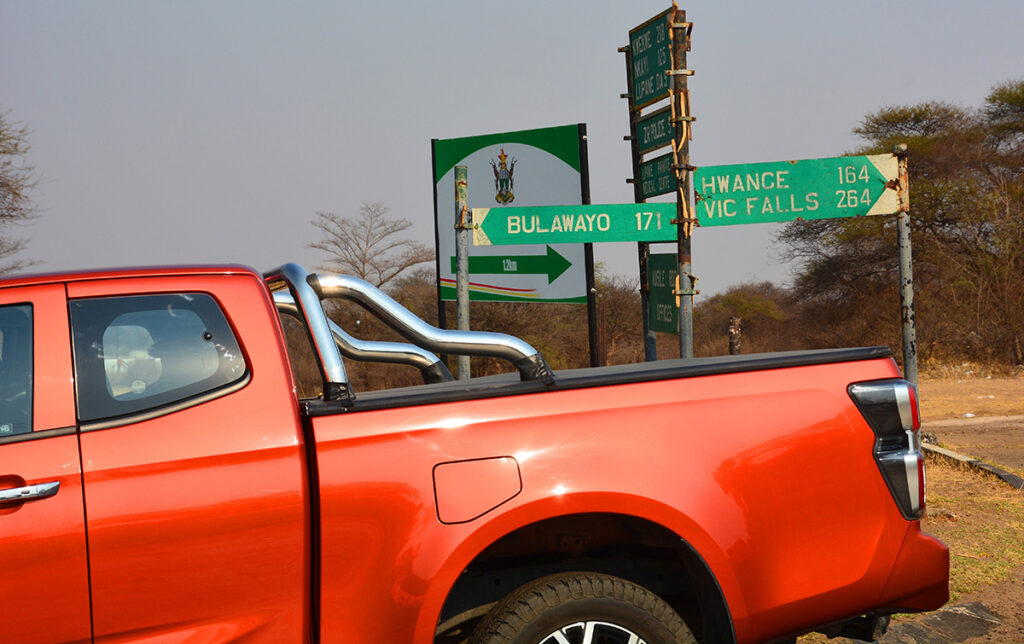
A Quadripoint
It is the only place in the world where four international boundaries meet, although technically it is a quasi-quadripoint, as the borders contain two tripoints joined by a short line of about 150 metres long forming the boundary between Zambia and Botswana…
Interestingly, this technicality saved the whole project, as the initial plan was to build a straight bridge over the river (some of the bridge pillars for this trajectory can still be seen on the Zambian side) but Zimbabwe then claimed it would cross its territory…
Realising this, Botswana and Zambia requested permission from Namibia to use some of its land. Namibia agreed, and the bridge was re-designed to form a curve over the small border strip between the two countries, in the process skirting Namibian soil but avoiding Zimbabwean territory…
Construction of the 18.5 m wide, 923-metre-long bridge with two traffic lanes and a single-lane railway track was financed by the Japan International Cooperation Agency and the African Development Bank, and it is now fast becoming the preferred border crossing for traffic from South Africa, routing through Botswana to avoid the congested Beit Bridge border post.
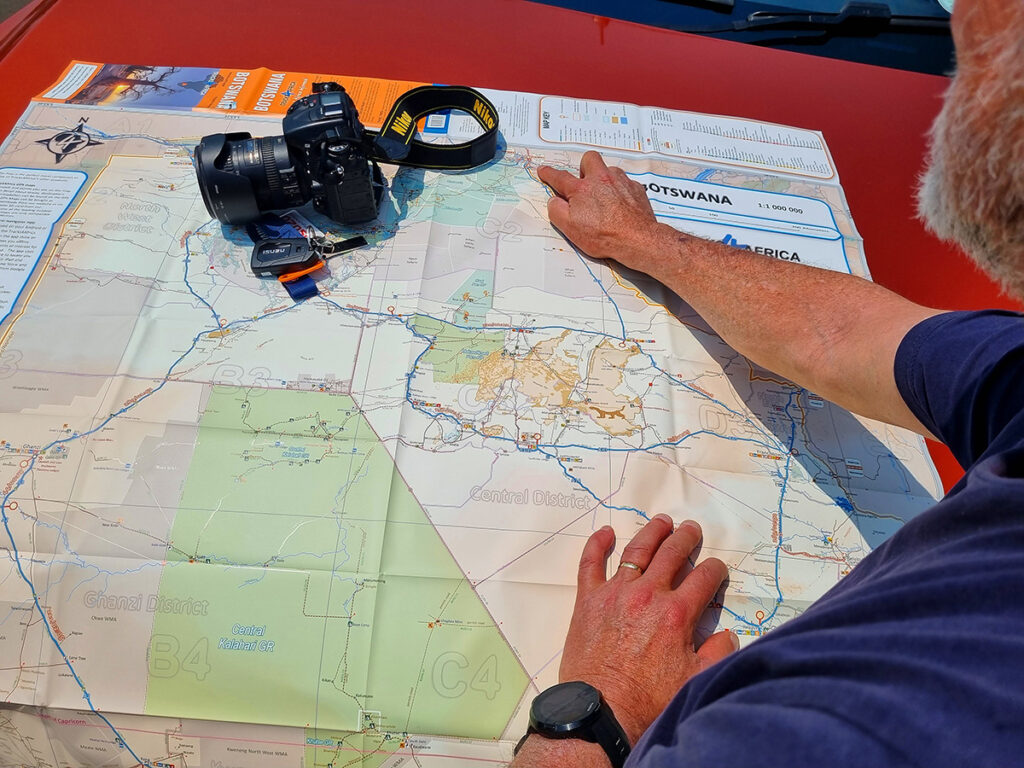
A long African legacy
The purpose of our trip from Gauteng to the African quadripoint in an extended cab Isuzu D-Max 3.0 Ddi LSE auto, shod with General Grabber AT3s (recently selected as the original equipment tyre for range-topping D-Max models) was to symbolise the growing exports of locally built Isuzu bakkies and Continental tyre products to countries such as Zimbabwe, Zambia, Botswana and Namibia.
In a bright burnt orange coloured seventh-generation D-Max bakkie, we also took the Botswana route, and at the Grobler’s Bridge border post we had to navigate our way around a seemingly endless line of trucks – including a car transporter laden with Isuzu pickups destined for Zambia…
The Isuzu legacy in Africa dates back over half a century when small Wasp and Florian pickups were exported to selected countries in small numbers. However, it was the Faster of 1972 (rebranded as KB or Chev LUV in export markets) that really enhanced the reputation of the Japanese manufacturer on the continent.
Introduced locally as the Chev LUV in 1978, the success of the KB led to Isuzu (then still part of General Motors) setting up a manufacturing facility in South Africa, and from the popular third generation model every KB model range were locally built and exported to a growing number of African countries.
In 2002, the KB designation changed to D-Max overseas but locally this switch only took place in 2018 with the introduction of the facelifted version of the sixth generation KB (second generation D-Max). Although the new, seventh generation bakkie was already launched in 2019, we had to wait until this year for local introduction, due to major upgrades of the Isuzu plant in Gqeberha.
A full range, from single to double cab in 4×2 and 4×4 guise with three trim levels and two engine options are now available – with our LSE derivative slotting in at the top of the extended cab range. Besides LED headlights and tail lamps, a tow bar and a chrome sports bar, the LSE has a 9-inch screen infotainment system and eight-speaker sound system inside, as well as front and rear park assist, and dual-zone automatic air-conditioning.
After crossing the border, the efficient air-con and well-proven 3,0-litre turbodiesel engine of the D-Max, now delivering 140 kW and 450 Nm in a calm and leisurely manner, shortened the long, hot road to Nata Lodge. Here we overnighted, and acquired Artie the bat-eared fox, our new travel companion… (see Backroads, p. 128)
The next day we set off towards Pandamatenga, and crossed into Zimbabwe, Border procedures were seamless and pleasant, and from the border post we followed the gravel road towards Matetsi and Victoria Falls. Even without four-wheel drive the D-Max and the Grabber AT3s were in their element on the undulating gravel track.
Although we had a slight brake problem on our D-Max (a brake bleed nipple came off) the award-winning 18-inch tyres took everything in their stride, again proving why it has been the tyre of choice for the Isuzu bakkie range for the past seven years and demonstrating its 75 years heritage in Africa.
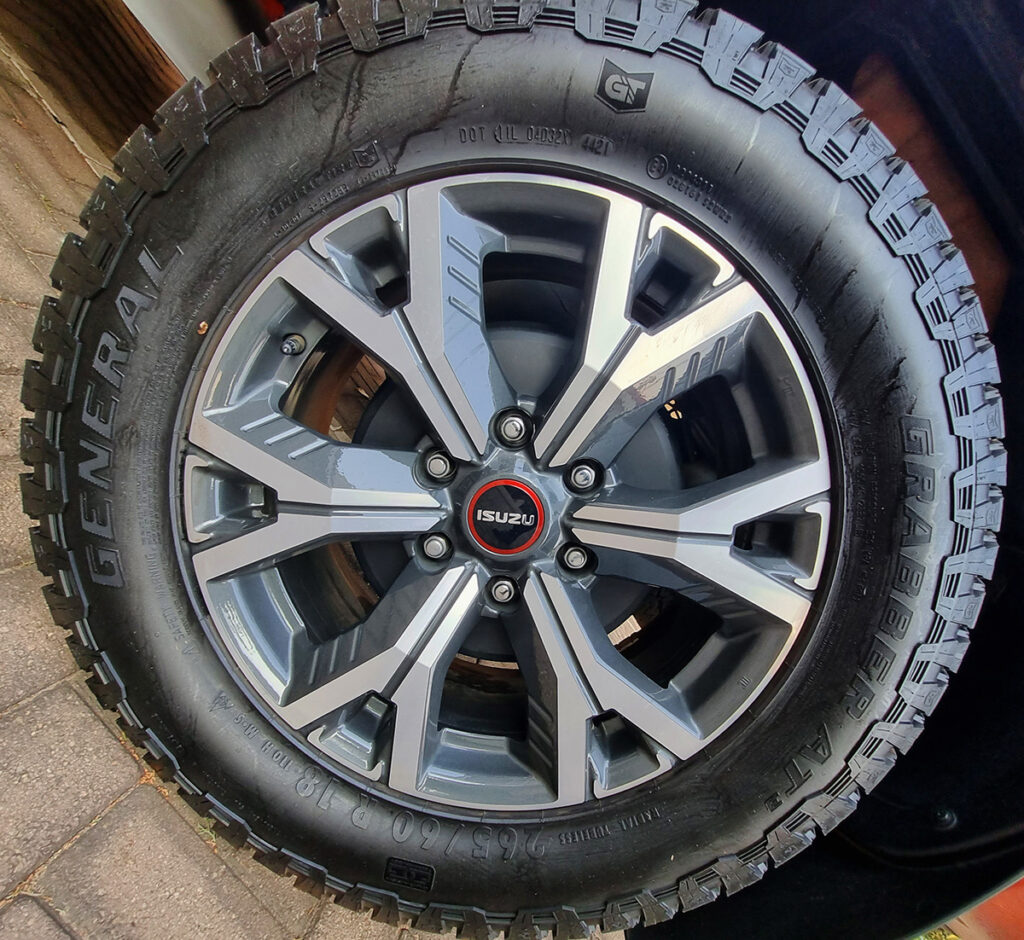
The Conti history
Continental Tyre has a rich heritage in Africa, beginning in 1947 with the founding of General Tire and Rubber Company South Africa in what is now known as Gqerberha. The local operation was acquired by Continental AG in 1998 and renamed Continental Tyre South Africa, helping cement its role as one of the leading tyre manufacturers in the country.
Celebrating its 75th anniversary this year, the only Continental tyre plant in Africa produces Continental and General Tire-branded tyres for some of the largest vehicle manufacturers in the country, and also exports tyres into Africa and around the world.
Renowned for outstanding all-round performance, durability and value for money, the General Grabber AT3 has become one of the most popular replacement tyre choices. The tyres feature ‘TracGen’, an open shoulder design with traction ridges for improved grip on all surfaces in its tread design, and sipes arranged at different angles to enhance water dispersion properties.
It also uses a robust rubber compound called ‘DuraGen’, providing excellent cut and chip resistance, and reducing tread block deformation, while its ‘ComfortBalance’ technology finds a good balance between on-road ride comfort and off-road grip.
In Vic Falls we managed to get the brake problem fixed to a degree (thank you, Levi Young) and spent some leisure time at our pleasant abode, the Shearwater Explorers Village, enjoying a well-earned beer or two. The next day, we did the short drive from Vic Falls to Kasane, again crossing the border without a hitch.
On the good tar road, the ride comfort of the D-Max was impressive, and we were in high spirits when we checked into the four-star Chobe Marina Lodge in Kasane, even though we could not get permission from the authorities to photograph the Isuzu at the ferry point on the Botswana side (the site is still closed to the public).
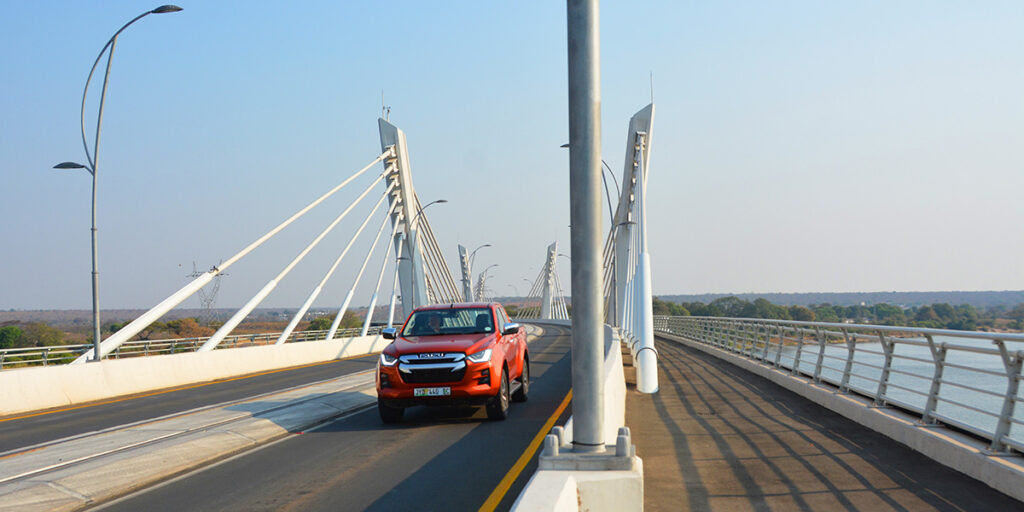
Into Zambia
We spent the rest of the day taking in the picturesque views and watching the sun set spectacularly over the Chobe River. After a hearty breakfast the following morning, we crossed the impressive Kazungula Bridge into Zambia. At the border post we were swamped by “fixers”, all promising to speed up the border procedures, for a fee, of course.
Navigating through the process, being sent from pillar to post, took nearly two hours but we finally did get though, with our D-Max now sporting a set of red and white stickers (apparently mandatory in Zambia…). We drove into the town of Kazungula, right up to the ferry point.
In Zambia, opposite Botswana and Zimbabwe, with the Namibian islands visible in the river and the bridge in the background, we were as close to the quadripoint as we could get…. and we spent the rest of the morning photographing the scene, as this is what we came for.
In stark contrast to the Kasane road, the potholed track leading from Kazungula to Sesheke and Katima Mulilo in Namibia was a road in name only… It is so potholed that a dirt track either side of the road is now the preferred thoroughfare but it allowed the General Grabbers to show its mettle in this atrocious conditions.
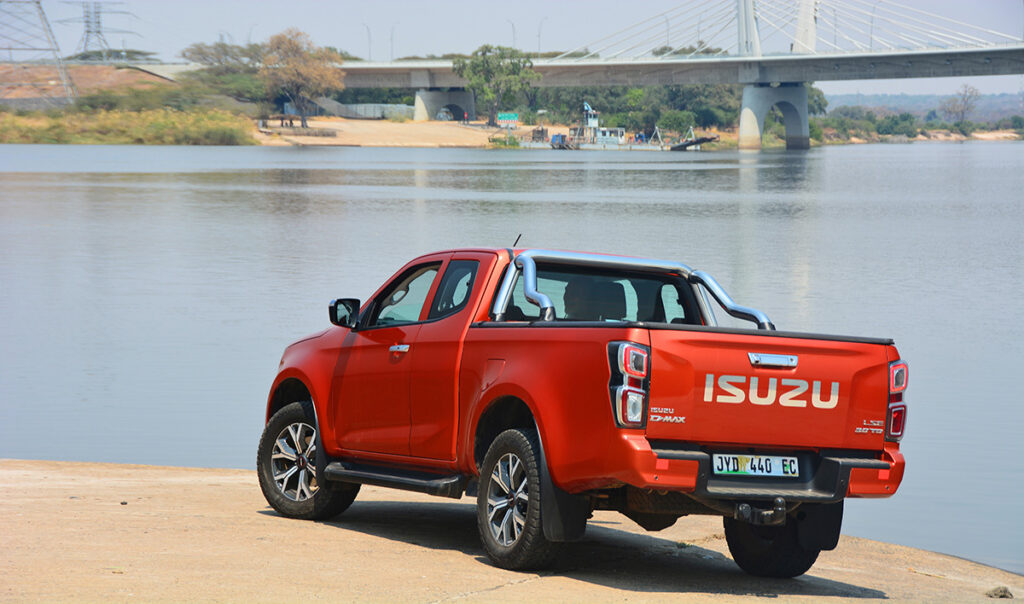
A perfect combination
Luckily, the road from Kazungula to Livingstone is in a much better state, and after a quick visit to the Royal Livingstone Hotel we crossed the bridge to Zimbabwe and Victoria Falls. After again staying over at the pleasant Explorer’s Village we journeyed back to South Africa. We passed numerous police check points on the way to Beit Bridge, all manned by friendly and courteous officers.
After fighting through the border post congestion, we were back on the N1 headed for Gauteng. Our average consumption on the round trip of close to 3 000 km to Kazungula and back, was 9.3 ℓ/100 km, not bad for a one-tonner bakkie. We encountered no further problems with the vehicle or tyres (although we would recommend dropping the tyre pressures slightly on bad roads).
With 75 years of tyre experience in Africa, and a 50-year legacy of one-ton pickups, the combination of Isuzu D-Max and General Grabber AT3 (now also available with painted sidewalls) proved perfect for conquering the African quadripoint.
Text: Ferdi de Vos | Images: Jim Freeman


